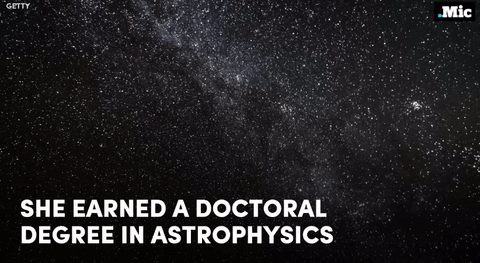Follow @the-future-now











follow @the-future-now
More Posts from Intergalacticnerd and Others


Do not go where the path may lead, go instead where there is no path and leave a trail. —Ralph Waldo Emerson

For the first time, astronomers have observed bursts of visible light being released by a black hole as it swallows matter from nearby stars.
These flashes of light, which lasted between several minutes to a few hours, were seen coming from a black hole in the Cygnus constellation, located about 7,800 light-years away from Earth. Incredibly, some of the flashes were so bright, the team says amateur astronomers could see them with a modest 20-cm telescope.
“We find that activity in the vicinity of a black hole can be observed in optical light at low luminosity for the first time,” astronomer and lead researcher, Mariko Kimura from Kyoto University in Japan, told Charles Q. Choi at Space.com.
“These findings suggest that we can study physical phenomena that occur in the vicinity of the black hole using moderate optical telescopes without high-spec X-ray or gamma-ray telescopes.”
Continue Reading.

The Hunter heads West
photo by rivermusic, March 14, 2016

NASA just released the most detailed photo of space ever taken
The picture of the Andromeda galaxy, the nearest spiral galaxy to our own, is comprised of a mind-boggling 1.5 billion pixels and was snapped from 2.5 million light years away by the powerful Hubble Space Telescope.
See it in all its glory








We used to look up at the sky and wonder at our place in the stars. Now we just look down, and worry about our place in the dirt.

Gravitational waves: discovery hailed as breakthrough of the century
Once again, Albert Einstein is proven right. Read more about this discovery in The Guardian.



We’ve always defined ourselves by the ability to overcome the impossible. And we count these moments. These moments when we dare to aim higher, to break barriers, to reach for the stars, to make the unknown known. We count these moments as our proudest achievements. But we lost all that. Or perhaps we’ve just forgotten that we are still pioneers. And we’ve barely begun. And that our greatest accomplishments cannot be behind us, because our destiny lies above us. - Interstellar, 2014.


NASA Astronomy Picture of the Day 2016 January 27
An Airglow Fan from Lake to Sky
Why would the sky look like a giant fan? Airglow. The featured intermittent green glow appeared to rise from a lake through the arch of our Milky Way Galaxy, as captured last summer next to Bryce Canyon in Utah, USA. The unusual pattern was created by atmospheric gravity waves, ripples of alternating air pressure that can grow with height as the air thins, in this case about 90 kilometers up. Unlike auroras powered by collisions with energetic charged particles and seen at high latitudes, airglow is due to chemiluminescence, the production of light in a chemical reaction. More typically seen near the horizon, airglow keeps the night sky from ever being completely dark.
-
 morningmask27 reblogged this · 2 weeks ago
morningmask27 reblogged this · 2 weeks ago -
 o2studies liked this · 1 month ago
o2studies liked this · 1 month ago -
 keys-home reblogged this · 1 month ago
keys-home reblogged this · 1 month ago -
 strawberry-muffin-crisis liked this · 1 month ago
strawberry-muffin-crisis liked this · 1 month ago -
 pumpkinpatch-kid reblogged this · 1 month ago
pumpkinpatch-kid reblogged this · 1 month ago -
 sillykittypaws liked this · 1 month ago
sillykittypaws liked this · 1 month ago -
 a-shower-of-roses reblogged this · 1 month ago
a-shower-of-roses reblogged this · 1 month ago -
 chompchain22 reblogged this · 1 month ago
chompchain22 reblogged this · 1 month ago -
 midknightsnack liked this · 1 month ago
midknightsnack liked this · 1 month ago -
 coldbrew-slut liked this · 1 month ago
coldbrew-slut liked this · 1 month ago -
 naanviolent reblogged this · 1 month ago
naanviolent reblogged this · 1 month ago -
 qualityblizzardcreation reblogged this · 1 month ago
qualityblizzardcreation reblogged this · 1 month ago -
 whistlesalot liked this · 1 month ago
whistlesalot liked this · 1 month ago -
 cavernofthewillowtree liked this · 1 month ago
cavernofthewillowtree liked this · 1 month ago -
 azorawing reblogged this · 1 month ago
azorawing reblogged this · 1 month ago -
 azorawing liked this · 1 month ago
azorawing liked this · 1 month ago -
 saladballad27 reblogged this · 1 month ago
saladballad27 reblogged this · 1 month ago -
 cupofcoca reblogged this · 1 month ago
cupofcoca reblogged this · 1 month ago -
 cupofcoca liked this · 1 month ago
cupofcoca liked this · 1 month ago -
 leenaisstudying liked this · 2 months ago
leenaisstudying liked this · 2 months ago -
 councillorenmagicked liked this · 2 months ago
councillorenmagicked liked this · 2 months ago -
 mouchiiarts reblogged this · 2 months ago
mouchiiarts reblogged this · 2 months ago -
 mouchiiarts liked this · 2 months ago
mouchiiarts liked this · 2 months ago -
 honeynebula reblogged this · 2 months ago
honeynebula reblogged this · 2 months ago -
 honeynebula liked this · 2 months ago
honeynebula liked this · 2 months ago -
 waitingforcatstotakeover liked this · 2 months ago
waitingforcatstotakeover liked this · 2 months ago -
 acemaii liked this · 2 months ago
acemaii liked this · 2 months ago -
 yuyanhere liked this · 2 months ago
yuyanhere liked this · 2 months ago -
 gerardwaygender reblogged this · 2 months ago
gerardwaygender reblogged this · 2 months ago -
 gothmuppetenthusiast reblogged this · 2 months ago
gothmuppetenthusiast reblogged this · 2 months ago -
 lawtism reblogged this · 2 months ago
lawtism reblogged this · 2 months ago -
 mylifeisjustaseriesofjokesonme reblogged this · 2 months ago
mylifeisjustaseriesofjokesonme reblogged this · 2 months ago -
 keys-home reblogged this · 2 months ago
keys-home reblogged this · 2 months ago -
 mylifeisjustaseriesofjokesonme liked this · 2 months ago
mylifeisjustaseriesofjokesonme liked this · 2 months ago -
 keys-home liked this · 2 months ago
keys-home liked this · 2 months ago -
 vertebratee liked this · 2 months ago
vertebratee liked this · 2 months ago -
 beangods reblogged this · 2 months ago
beangods reblogged this · 2 months ago -
 beangods liked this · 2 months ago
beangods liked this · 2 months ago -
 winryrockbellwannabe reblogged this · 2 months ago
winryrockbellwannabe reblogged this · 2 months ago -
 winryrockbellwannabe liked this · 2 months ago
winryrockbellwannabe liked this · 2 months ago -
 contrarynonsense reblogged this · 2 months ago
contrarynonsense reblogged this · 2 months ago -
 kierranodel liked this · 2 months ago
kierranodel liked this · 2 months ago -
 studyblrspace reblogged this · 2 months ago
studyblrspace reblogged this · 2 months ago -
 studyblrspace liked this · 2 months ago
studyblrspace liked this · 2 months ago
"Astronomy compels the soul to look upwards and leads us from this world to another." - Plato
147 posts
